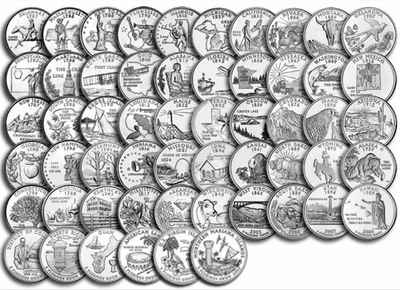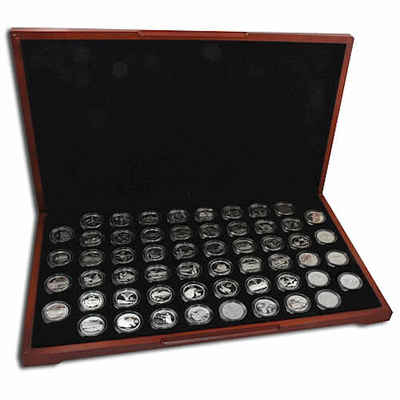
Utah Symbols
Utah 50 State Quarter
50 State Quarter of Utah

Designed by Joseph F. Menna
Released November 5, 2007
Utah is a western state defined by its vast expanses of desert and the Wasatch Range mountains. Utah is known for its natural diversity and is home to features ranging from arid deserts with sand dunes to thriving pine forests in mountain valleys. It is a rugged and geographically diverse state that is located at the convergence of three distinct geological regions: the Rocky Mountains, the Great Basin, and the Colorado Plateau. Utah became the 45th state on January 4, 1896, becoming our Nation's 45th state.
Mintage: 508,200,000
The fifth and final commemorative quarter-dollar coin released in 2007 honors Utah, and is the 45th coin in the United States Mint's 50 State Quarters® Program. The 50 State Quarter of Utah was released on November 5, 2007, featuring two locomotives moving toward the golden spike that joined the Central Pacific and Union Pacific railroads, linking the east to west coasts of the United States. On May 10, 1869, two steam locomotives met at Promontory, Utah, for the "Joining of the Rails Ceremony." The event marked a turning point in the development of the American West making cross-country travel more convenient and economical. Inscription: "Crossroads of the West."
Utah 50 State Quarter
The fifth and final commemorative quarter-dollar coin released in 2007 honors Utah, and is the 45th coin in the United States Mint's 50 State Quarters® Program. Utah was admitted into the Union on January 4, 1896, becoming our Nation's 45th state. The reverse of Utah's quarter features two locomotives moving toward the golden spike that joined the Central Pacific and Union Pacific railroads, linking East to West and transforming both the Utah Territory and the Nation with the inscription "Crossroads of the West." The coin also bears the inscriptions "Utah" and "1896."
On May 10, 1869, two steam locomotives met at Promontory, Utah, for the "Joining of the Rails Ceremony," at which the Union Pacific and Central Pacific railroads completed the transcontinental route. The event was crucial to the development of the American West because it made cross-country travel more convenient and economical. The construction of the railroad, and the subsequent mining boom, brought diverse ethnic and religious populations to Utah. The railroad also symbolized the changing technology, and moved Utah from an agrarian economy to a more industrialized one.
Even before the time of steam locomotives, Utah experienced a steady flow of explorers and pioneers. The Spaniards first came to explore Utah in the 18th century and were followed by mountain men, Mormons and prospectors in search of precious metals found in the 1860s. Because of its central location, Utah became known as the "Crossroads of the West."
The Utah Commemorative Quarter Commission invited narrative submissions from the citizens of Utah. The Commission received approximately 5,000 submissions and recommended three concepts to the United States Mint for rendering by the United States Mint sculptor-engravers and artists in the United States Mint's Artistic Infusion Program. More than 150,000 citizens voted in a 25-day statewide vote in April 2006. "Crossroads of the West" prevailed as the favorite design among voters. Governor Jon M. Huntsman, Jr., announced the State's recommendation at the Golden Spike National Historic Site in Promontory on May 10, 2006, the 137th anniversary of the Joining of the Rails.
The Department of the Treasury approved the design on June 22, 2006. The two other design concepts considered were the "Beehive," featuring a beehive, part of the official seal and State emblem of Utah, symbolizing industry and working together for common purposes, and "Winter Sports," featuring a female snow boarder and celebrating Utah as a world-class winter sport destination and the site of the 2002 Winter Olympics.
Source: United States Mint's 50 State Quarters Program







